Alberni Residential School
Dates of Operation
1892–1899 (Alberni Girls’ Home); 1900–1966 (Alberni Residential School); 1967–1973 (Alberni Student Residence)
Managed by the Women’s Foreign Missionary Society of The Presbyterian Church in Canada and, from 1925 to 1969, by the United Church of Canada. It was then taken over and run by the Department of Indian Affairs.
Location
On the west bank of the Somass River, Vancouver Island, British Columbia, just south of the Tseshaht reserve Tsahaheh 1 and about 4 kilometres north of Port Alberni.
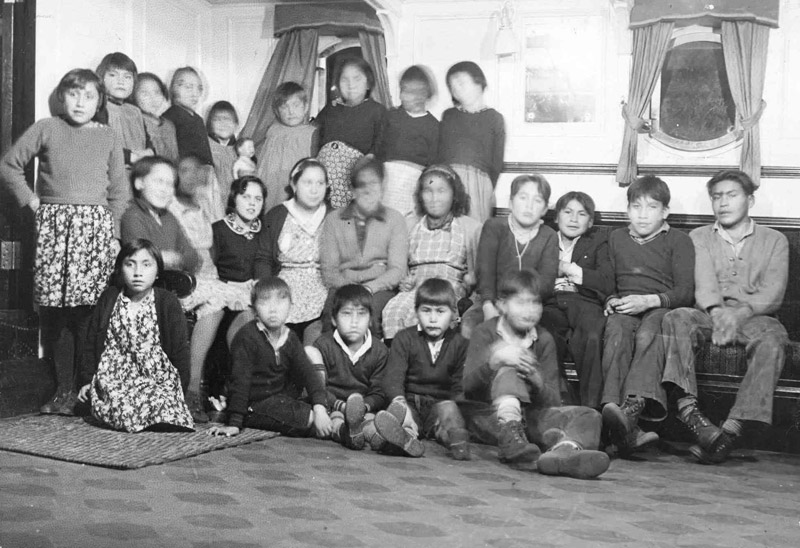
As a young boy of pre-school age, and later as an elementary school student, I was threatened by my mother with the possibility of being sent to the “boarding school.” When I was particularly mischievous or poorly behaved, Mama, and at times my older brothers and sisters would scold, “behave yourself or I’ll send you to boarding school!” Boarding school was what we called the Alberni Indian Residential School. We thought of it as the ultimate punishment, often threatened, but for me never realized. Before I had ever set eyes on the daunting red [b]rick main building, I have imagined it prison-like. Boarding school was scary.
Ron Hamilton, in Nuu-chah-nulth Tribal Council, Indian Residential Schools: The Nuu-chah-nulth Experience
(Port Alberni, British Columbia: Nuu-chah-nulth Tribal Council, 1996), xxi.
In 1891, the Presbyterian Church sent out its first missionary to Vancouver Island, British Columbia, to work among the Indigenous peoples there. After visiting several other communities, Reverend John A. MacDonald settled near the Tseshaht reserve at the head of Alberni Inlet, where he built a mission house and conducted a day school in a house on the reserve loaned to the church by a Tseshaht man named Santa. [1] The following year, hoping their children would benefit from the new opportunities an education promised, community members asked that MacDonald also establish a boarding school so children could continue to study and their parents, participate in the sealing industry on the west coast of the island. [2] Two boys living at the mission house with MacDonald helped him learn the Nuu-chah-nulth language the Tseshaht and neighbouring Hupacasath people spoke. MacDonald applied to the Department of Indian Affairs for a grant to bring more children into the home before the Tseshaht left in June for salmon fishing, but the government agreed only to a day school grant. [3] By 1893, MacDonald became ill and resigned his post.
Alberni Girls’ Home
In the same year, the Women’s Foreign Mission Society of the Presbyterian Church took over the administration and funding of what was now called the Alberni Girls’ Home and acquired 16 acres of land on which Tseshaht community members built a schoolhouse.[4] The day school opened in September with attendance by children from the Tseshaht reserve as well as from the 13 children boarding in the home. Staff comprised the missionary, a matron, a teacher, and a man in charge of the outdoor work. Attendance at the school was uneven, however, because many children continued to accompany their families on fishing and sealing expeditions.
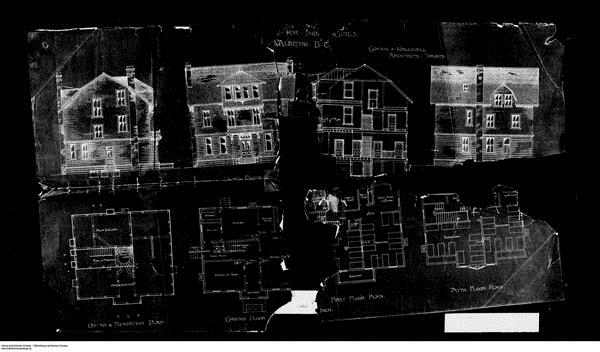
The WFMS also planned for a new building, which would house 40 to 50 children. The Department of Indian Affairs, which was consulted regarding the building’s layout, provided $1,500 toward construction and paid the teacher’s salary but did not allow a per capita grant.[5] Completed in 1896, the home opened with 16 girls in residence, ranging in age from 18 months to 16 years, as well as 11 boys ages 5 to 14. The church designed the home without bathrooms on the main floor and in the attic, where the girls slept, in order “not to indulge that class of children with too many of the modern conveniences.”[6] In response to Department of Indian Affairs concerns about the practice, matron Bella Johnston claimed that the children enjoyed the “health activity of bathing in the river, even when snow was present.” The church later agreed to add bathrooms.
The children continued to take their academic classes in the schoolhouse alongside day students. In the home, Johnston reported that while girls were taught “all sorts of women’s work,” including bread making, laundry, knitting, dressmaking, hat making, and music, little provision was made for the boys’ training “outside of gardening and wood-cutting.”[7]
Although children lived in residence, they had some opportunities to visit with their families. Older students went home Saturday afternoons, and parents attended Sunday service at the mission with their children. It was also common to let older children out of school to accompany their families on fishing and sealing expeditions.[8] The Presbyterians saw such contact as a way to improve the “moral and material life” of the reserve and to instil Christian ideas about appropriate gender roles. They hoped the girls, for example, would use their Saturday visits to “impart to the younger married women the instruction received in the home, with the result that good bread, nicely prepared food and clean homes are becoming the order.”[9] The Girls’ Home staff also attempted to curb liquor drinking, card playing, and ceremonial practices integral to Nuu-chah-nulth culture and society. Home staff also attempted to have “Indian doctors” expelled from the community and to replace them with Western health regimes: “Besides what is done for those in the home, the sick and sore of all ages are looked after, fed, and made as comfortable as we can in their own homes. Plain coffins are made for a good many of their dead, and they are decently buried.”[10]
Many children became ill and died, both on the reserve and at the school.For example, in 1896, the teacher, E. May Armstrong, wrote,
This year, so far has been one of sadness to us all. On the second of June we laid in the grave our boy, Kenneth, making the sixth from our little bands at Alberni since January. Three died within one month. First—our girl Polly. She had been ill of consumption all winter and towards the spring sank rapidly and died on May 3rd. Just three weeks later, Peter, a man past-middle age went to the home above. He had been ill only about three months, and, until the last two weeks we did not think his illness would end in death…Our hearts were very sore to part even for a little while with those dear ones.[11]
E. May Armstrong to Mr. McKay, June 4, 1896
Although described as a particularly sad year, 1896 was not atypical. Reports to the missionary society routinely detailed multiple deaths in the home and the community, most from tuberculosis but also a number from other ailments such as chicken pox, whooping cough, and pneumonia. Home staff were affected by illness as well. MacDonald’s sister, who was the first teacher, died of tuberculosis soon after the school opened, and the first matron, Elizabeth Lister, died in January 1893 of pneumonia. MacDonald himself retired the same year due to poor health, at the age of 32.[12]
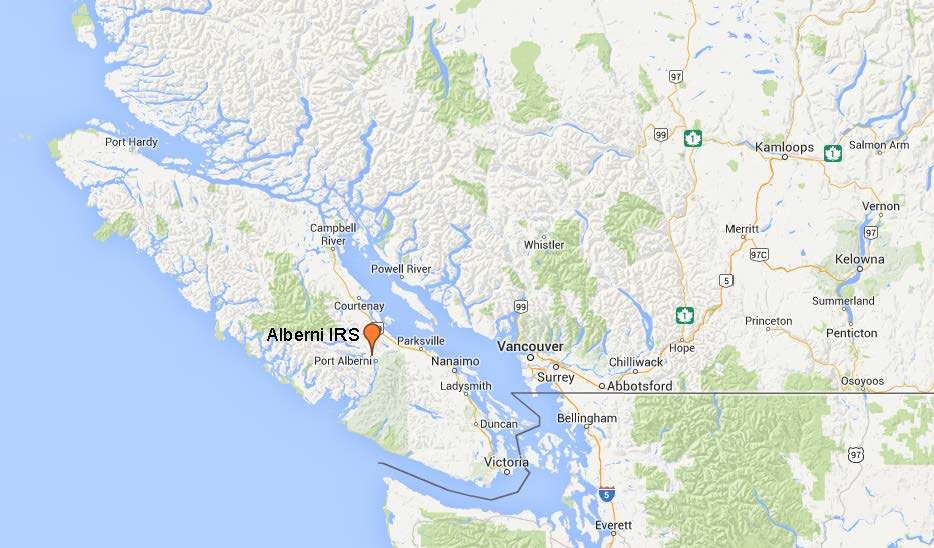
Alberni Residential School
As the number of boarders in the Girls’ Home increased and as boys began to outnumber girls, the Women’s Foreign Mission Society again approached the Department of Indian Affairs for a per capita grant. This time, the Department of Indian Affairs agreed to provide $60 per capita for up to 30 students and in December 1899 reclassified the home as a boarding school. Thirty-three pupils were enrolled: 21 boys and 12 girls. Although most children continued to come from the nearby Tseshaht and Hupacasath communities, the school now began to recruit from the different Nuu-chah-nulth nations of Barclay Sound.[13]
School authorities soon found the building too small and began to make plans to enlarge it. They also hoped to convince the government to convert Alberni Residential Schools into a much larger industrial institute.[14] To this end, in 1904 the Women’s Foreign Mission Society paid for a new building that would house the principal, a hospital, staff accommodation, and other rooms, making space in the main building for up to 60 children. The government raised the number of students covered by the per capita grant to 50 but did not classify the school as an industrial institute.
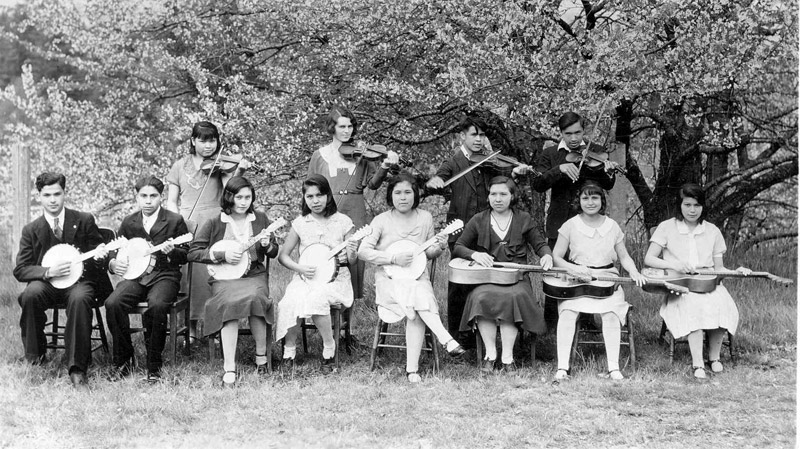
The boys in residence helped to build the new school, doing “most of the sheeting and rustic work, all the shingling and most of the lathing. They laid nearly all the floors and put on the wainscotting.”[15] The boys were also taught shoe repair and sometimes fixed shoes for the local non-Indigenous community.[16] In addition, they baked the school’s bread, helped the girls with the laundry, and fished for the school. In 1907, the children—boys and girls—made a large gill-net to increase the catch, and in 1911, they packed ten barrels of salmon.[17] Girls, meanwhile, learned to bake, care for milk and butter, can fruit, cook, and sew. They were also taught music.
Religious instruction, always a priority, included a great deal of memorization. Principal James Motion reported in 1904, “Three children under ten have memorized one hundred verses of Scripture and received certificates; five have memorized the Shorter Catechism, eight others have memorized two hundred verses of Scripture.”[18] Motion saw Christianity as the means of eradicating the practices the Presbyterians found offensive, such as the Klukwana and the potlatch. “As soon as the people become Christian so soon will they give up those customs,” he wrote. “The hardest battle fought by our ex-pupils is the persistent endeavour of the older people to make them take part in those dances, so that the dances may be continued in the future.”[19] These ceremonies were central to Nuu-chah-nulth society and governance systems and persisted despite the efforts of church and state.
Poor health among the students continued to be a concern in the boarding school. In 1909, W.A. Hendry alerted the Church that too many children were dying while under the school’s care. To make his point, he provided a long list of children who had passed away at the school or soon after they had been sent home.[20]
Farming
Although Alberni Residential School was situated on 16 acres of good soil, most of it was heavily timbered and very expensive to clear. For that reason, until 1906, the school never had more than six acres under cultivation. The crop consisted mostly of potatoes and other vegetables but there were also more than 200 fruit trees providing apples, pears, peaches, cherries, and plums and other small fruits.[21] The school kept two to three horses and a few cows for milk and butter, which they grazed in a rented field. In 1903, the children were given individual garden plots to tend.
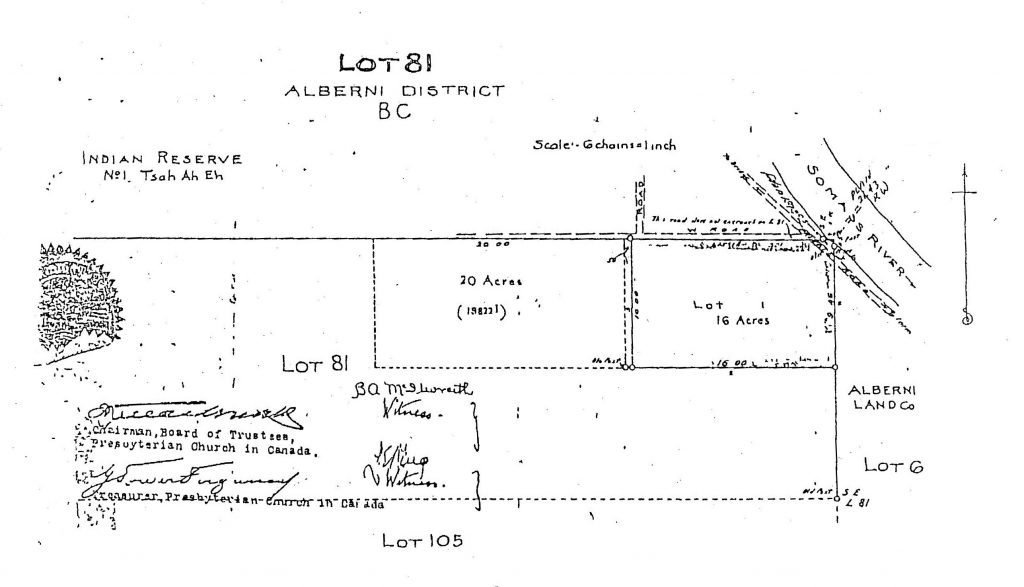
In 1906, the Presbyterian Church bought the remainder of the lot on which Alberni IRS was situated—160 acres, 20 of which was sold off the following year. With the new purchase, the school crop expanded slightly to include hay and, in later years, oats, but the amount of land under cultivation remained small. For many principals, there was no point in training the students in farming because, as Principal Currie noted in 1926, it was “the least likely industry to be practiced by the boys after leaving school.”[22]
By 1911, there were 11 acres cleared and planted, and by 1915, there were 17. For many years, the school continued to rent pasture land. For a long time, the number of stock animals also remained small, with the exception of the chickens, which by 1913 numbered 180. In some years, the children raised pigs as well, and under Principal Currie, they kept a herd of more than 30 pure bred dairy cows. The herd was sold in 1951, and the farm greatly reduced.[23] By 1958, operations had ceased altogether.[24]
Fire and a New Building
On June 2, 1917, Alberni Residential School burned to the ground. No one was hurt, but only the schoolroom and some outbuildings survived. The WFMS proposed that the government take over the site and rebuild a larger school for the children at Alberni as well as those at Ahousaht on the west coast of Vancouver Island, where the only other Presbyterian residential school in the province had burned down the year before.[25]
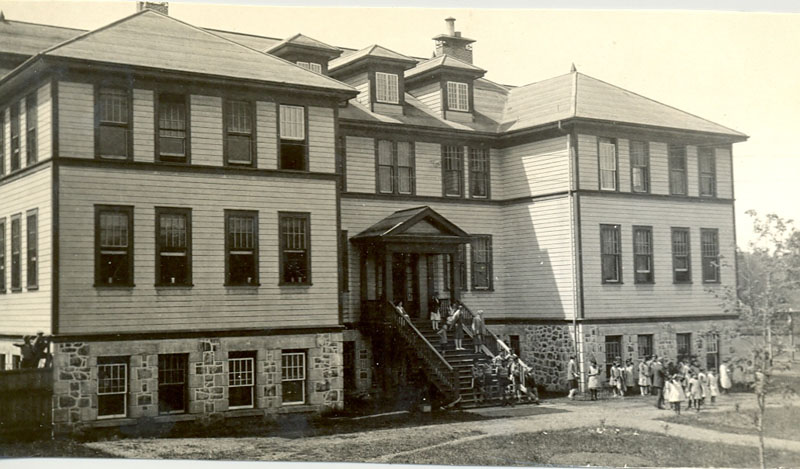
Meanwhile, the children were either sent home or housed in temporary accommodations that were “practically devoid of sanitary arrangements.” It was the time of the Spanish flu pandemic (1918–1919) and at one point every child and staff member was reported to be ill.[26]
In the end both Alberni Residential School and Ahousaht Residential School were rebuilt. The Presbyterian Church conveyed the 16-acre site at Alberni to the DIA with the agreement that the department would build a new school. A new and enlarged Alberni Residential School opened December 1, 1920, with room for 100 students. In 1921, the DIA approved a per capita grant for up to 80 boarders. By 1929, the per capita grant covered up to 115 students, recruited from different Vancouver Island communities.
Curriculum in the new building was, for the boys, limited to farm work: dairying, hog and poultry raising, and crop cultivation. In 1925, Principal Currie again asked the DIA to convert the school into an industrial institute, with shops and instructors.[27] No reclassification was made, but in 1929, the DIA approved a grant to hire a manual instructor.[28] According to one DIA inspector, the grant made little difference. In 1932, he reported, “No worthwhile Manual Training has been done in this school so far this year.”[29]
Another Fire and Another Building
In February 1937, Alberni Residential School was again destroyed by fire, fortunately without injury or loss of life. Most of the 112 children in residence were sent home and, except at Ucluelet where there was a day school, did not attend school.[30] Following the Alberni fire, the DIA proposed moving the residential school to Ucluelet, but the United Church insisted on rebuilding at Alberni. By the time the new building opened in February 1941, both Ahousaht Residential School and Coqualeetza Residential School, on the mainland, had closed. The new school, under Principal R.C. Scott, had accommodation for up to 200 students, drawn from communities across the province, and offered vocational training in carpentry, motor mechanics, boat building, navigation, sewing and mending, Native handicrafts, cooking, and laundry. Boys learned how to bake bread, anticipating future employment in the fishing industry and on seine boats. The intention, wrote one Department official, was to make Alberni Residential School “the most up to date and the best equipped Indian residential school in the Dominion.”[31] In 1948/49, the school finally made the switch from half-day to full-day schooling.[32]
Relationship with Tsehaht First Nation
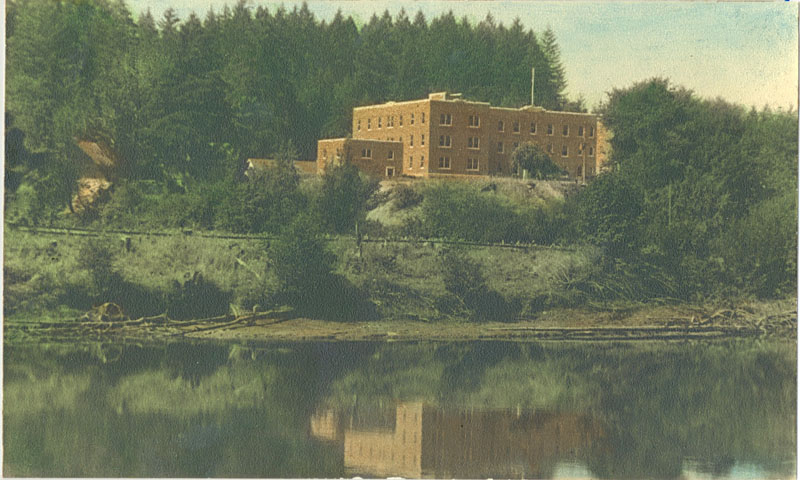
During the early years of Alberni Residential School, administrators promoted close relations between the school and the Tseshaht community immediately adjacent to it in hopes that the school would have an “elevating effect” on the children’s parents.[33] But over time, especially as the proportion of students coming from more distant communities grew, Alberni Residential School became isolated from the reserve. By 1943, the Inspector of Schools considered the proximity of the residential school to the students’ homes a “handicap” to their efforts of assimilation.[34]
Administrators and officials saw members of the local Indigenous community who opposed the school as a source of potential disruption and attacks, even arson. To defend themselves against such perceived threats, in 1928, Principal Pitt instructed the architect brought in to install fire escapes to ensure that the fire escapes would have no access from the ground to the dormitories.[35] And in 1941, the school had a fence built around its property and church authorities petitioned, without success, to have any nearby houses removed.[36]
But there was also concern about the influence the students of the residential school might have on local Indigenous communities that officials considered more advanced. In the 1940s, when the DIA was reviewing proposals for a separate day school for Tseshaht and Hupacasath children, one inspector recommended putting the river between the day school and Alberni Residential School.[37]
In 1948, a day school was opened in order to make room at Alberni Residential School for children from more distant reserves. The old classroom building, which had survived both the Alberni Residential School fires, was moved onto the Tseshaht reserve to serve as the schoolhouse. By 1950, however, children from the reserve were attending the provincial school—Gill Elementary—across the river in Port Alberni.[38]
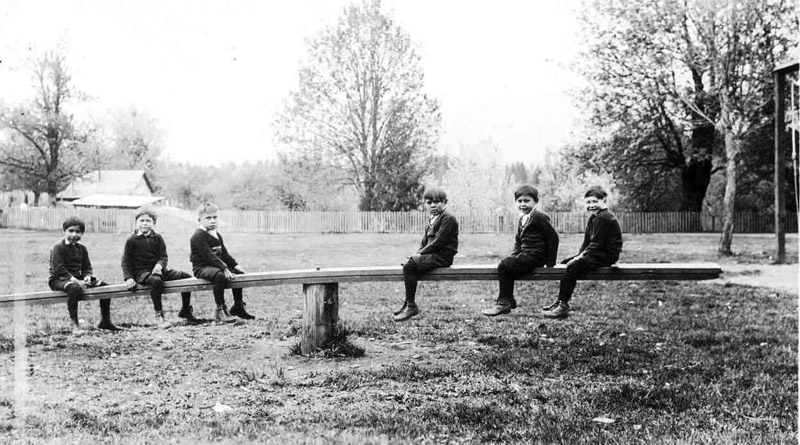
Mistreatment and Abuse
Many former students of Alberni Residential School have testified to the physical and sexual abuse that occurred there. A number of these accounts eventually led to court action against two of the worst known abusers at the school. They resulted in convictions in the late 1990s against former boys’ supervisor Arthur Henry Plint on 36 counts of sexual assault committed between 1948 and 1968 and in 2003, against dorm supervisor Donald Bruce Haddock, who pleaded guilty to four counts of indecent assault which occurred at Alberni Residential School between 1948 and 1954.[39] Plint’s trial led BC Supreme Court Justice Douglas Hogarth to declare “the Indian residential school system was nothing more than institutionalized pedophilia” and prompted an RCMP investigation of schools across British Columbia.
Allegations of mistreatment were also made while Alberni Residential School was still operating. In 1918, a report of severe physical abuse by an employee of the school reached the DIA, and in 1922 Andrew Paul of the Allied Tribes of BC relayed reports that an employee “unmercifully whips the boys on their back” as well as kicking them, hitting them with fists, and choking them.[40]
Such was Alberni Residential School’s reputation, that when it was destroyed by fire in 1937 and some of the staff and students were transferred to Ahousaht Residential School, school inspector Gerald H. Barry complained, “Children have come here from Alberni Indian Residential School, where every member of the Staff carried a strap…These children have never learned how to work without punishments.”[41] Barry had particularly strong words for the girls’ supervisor brought from Alberni: “Though her ideas of constant punishment have been considerably curtailed by the Principal, her influence on staff and girls is distinctly poor in my opinion. She will be permitted to resign at the end of June and will I hope never be again employed in an Indian school.”[42]
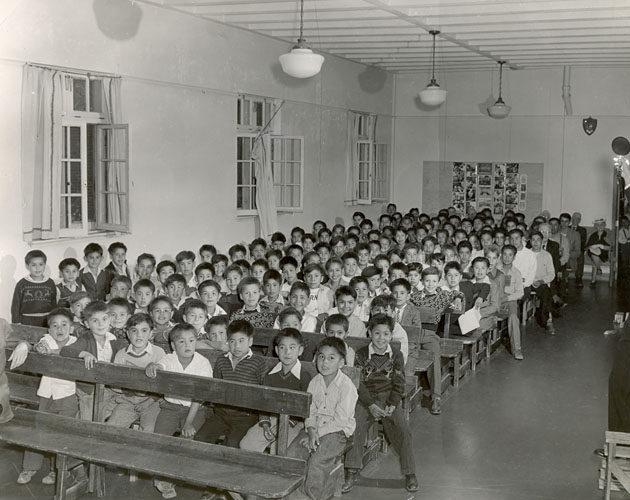
UCCA, 1993.049P/432
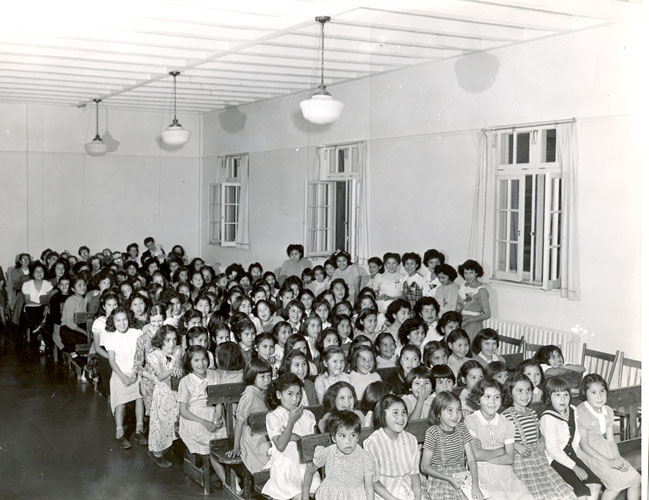
UCCA, 1993.049P/433
Expansion and Integration
In 1950, the DIA took over hiring and paying teachers, who now had to meet the same qualifications as public school teachers.[43] But Alberni Residential School’s days as a place of instruction were numbered—integration was the new trend. As early as 1934, high school students boarding at Alberni IRS had attended public schools in Port Alberni, but in the 1950s increasingly younger children were integrated.[44] In 1957, grades 7, 8 and 9 started attending A.W. Neill Junior High School, and by 1964 only kindergarten to grade 3 students were still being taught in the residential school classrooms.[45] By 1966, students from grades 1 through 8 were taking their classes in public schools, and the next year, Alberni Residential School officially became the Alberni Student Residence.[46]
On April 1, 1969, with 300 children in residence, the federal government took over management of Alberni Residential School.[47] The following years would see a sharp decline in enrolment as more and more students opted to take classes in day schools in their home communities.
Closing
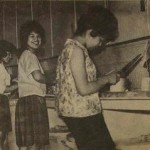
In 1973, the West Coast District Council of Indian Chiefs, dissatisfied with both the poor operation of the residence and its very concept, called for Alberni Residential School’s closure.[48] Council members also noted that many students had to travel great distances from their communities even though there existed schools much closer by. In its response, Indian and Northern Affairs acknowledged that the issues facing Indigenous peoples “can’t be solved by sending children 800 miles away from their homes” and ordered the residence closed.[49] Students who were still in residence when Alberni Residential School closed its doors Aug. 31, 1973, were placed in accommodations closer to their homes.[50]
Following the residence’s closure, the West Coast District Council leased the complex for the administrative offices of its 13 member First Nations and in 1976 the Tseshaht First Nation took the buildings over. In 1980, the federal government, in response to Tseshaht petitions claiming the land that went back to 1967, added the 15.6 acres on which the buildings stood (Lot 1 of Lot 81) to the First Nation Tsahaheh Indian Reserve No. 1.
Years later, on February 10, 2009, the Tseshaht First Nation welcomed former students and boarders to participate in the demolition of Peake Hall, the high school student dormitory built in 1954, “using traditional and cultural methods to take the power away from the school once and for all.”[51]
Footnotes
- Henry Guillod, Indian Agent, to Secretary General of Indian Affairs (SGIA), Sept. 1, 1893, Department of Indian Affairs (DIA) annual reports, 1893, pp. 118–119; “This Indenture…,” Sept 4, 1893, no. 17207, Absolute Fees Book, vol. 15, folio 625, B.C. Provincial Land Registry. ↩
- John A. MacDonald to Hamilton Cassells, January 12, 1892; and John A, MacDonald to Mr. Ross, July 5, 1892, Presbyterian Church, Foreign Mission Committee, Women’s Society, “Indian Work in British Columbia,” box 1 file 1, UCCA. ↩
- Guillod to A.W. Vowell, Indian Superintendent, Mar. 15, 1892, RG10, vol. 6433, file 877-5, pt. 1; DIA annual reports, 1892, p. 296. ↩
- R.P. MacKay, FMC [Foreign Mission Committee], to Hayter Reed, Superintendent General, Nov. 8, 1893, RG10, vol. 6433, file 877-5, pt. 1, LAC. ↩
- [Graham?], [DIA], to R.C. Scott, principal, Feb. 15, 1941, RG10, vol. 6431, file 877-1, pt. 3, LAC; DIA annual report, 1896, p. 406. ↩
- Rev. P.R. MacKay, Feb. 7, 1895, RG10, vol. 6433, file 877-5, pt. 1, LAC. ↩
- B.I. Johnston, in charge of Indian Girls’ Home, to SGIA, Sept. 23, 1896. ↩
- See, for example, Guillod to SGIA, Oct. 7, 1899, DIA annual reports, 1899, pp. 264–269, and Guillod to SGIA, Sept. 18, 1900, DIA annual reports, 1900, pp. 278–282. ↩
- Johnston to SGIA, Sept. 23, 1896.↩
- Ibid. ↩
- E. May Armstrong to Mr. McKay, June 4, 1896, accession 1979.200C, box 1, file 10, Presbyterian Church in Canada Mission to Indians in British Columbia (April-June 1896), UCCA. ↩
- Guillod to SGIA, Sept. 1, 1893. ↩
- McKay to Deputy SGIA, Dec. 27, 1899, RG10, vol. 6431, file 877-1, pt. 1, LAC. ↩
- Martin Benson to Deputy SGIA, Mar. 24, 1904, RG10, vol. 6431, file 877-1, pt. 1, LAC. ↩
- James R. Motion, Principal, to SGIA, July 28, 1904, DIA annual reports, 1904, pp. 391–393. ↩
- Ibid. ↩
- “Alberni Boarding School (Presbyterian), Northwest Coast Agency,” DIA annual reports, 1907, pp. 431–432; “The Report of H.B. Currie, Principal of the Alberni Boarding School, Alberni, B.C., for the Year Ended March 31, 1911,” DIA annual reports, 1911, pp. 493–494. ↩
- Motion to SGIA, July 28, 1904. ↩
- Ibid. ↩
- W.A. Hendry to Dr. R.P. MacKay, Oct. 28, 1909, accession 1979.200C, box 4, file 128, UCCA. ↩
- Motion to SGIA, July 9, 1903, DIA annual reports, 1903, pp. 408–409. ↩
- Currie to W.E. Ditchburn, Indian Commissioner, January 16, 1926, RG10, vol. 6431, file 877-1, pt. 2, LAC. ↩
- W.A. Evans, Treasury Auditor, to W. Lauchlan, Chief Treasury Officer, Mar. 13, 1951, RG10, vol. 8845, file 958/76-2, pt. 1, LAC. ↩
- F. Harrop, Treasury Auditor, to H.G. charlton, Regional Administrator, Office of the Comptroller of the Treasury, May 27, 1959, RG10, vol. 8845, file 958/76-2, pt. 1, LAC. ↩
- Benson to Scott, Aug. 6, 1917, and J.H. Edmison, Secretary, to Scott, July 2, 1917, RG10, vol. 6431, file 877-1, pt. 1, LAC. ↩
- [illeg.] Seck, City Clerk, to Scott, Oct. 30, 1918, RG10, vol. 6431, file 877-1, pt. 1, LAC. ↩
- H.B. Currie, principal, to D.C. Scott, Mar. 26, 1925, RG10, vol. 6431, file 877-1, pt. 2, LAC. ↩
- J.D. McLean, Assistant Deputy and Secretary, DIA, to Pitts, Oct. 25, 1929.↩
- “Extract from Inspector Barry’s Report regarding His Visit to the Alberni Indian Residential School on April 26th, 1932,” RG10, vol. 6431, file 877-1, pt. 2, LAC. ↩
- D.M. MacKay, Indian Commissioner, to Hoey, June 1, 1937, RG10, vol. 6431, file 877-1, pt. 2, LAC. ↩
- [Graham?] to R.C. Scott, Feb. 15, 1941. ↩
- R.F. Davey, District Inspector of Indian Schools, to Indian Commissioner, memo, May 6, 1947, RG10, vol. 6431, file 877-1, pt. 4, LAC. ↩
- Motion to SGIA, July 9, 1903. ↩
- W.E. Manning, Inspector of Schools, “Alberni Indian Residential School,” June 1943, RG10, vol. 8453, file 985/23-5, LAC. ↩
- Pitts to DIA, June 15, 1928. ↩
- Barry to D.M. MacKay, July 12, 1941. ↩
- H.M. Morrison, “Inspector’s Report: Alberni Residential Indians School,” Jan. [15?], 1945, RG10, vol. 6431, file 877-1, pt. 4, LAC. ↩
- Philip Phelan, Superintendent of Education, DIA, to George Dorey, Secretary, Board of Home Missions, Aug. 7, 1953, RG10, vol. 6420, file 860A-5, pt. 1, LAC. ↩
- David Wilson, “Not Liable, but Still Responsible,” United Church Observer, 2004; Jeff Holubitsky, “Tofield Man Jailed for 1950s Sexual Abuse of Children,” [Edmonton Journal], January 24, 2004. ↩
- “Extract from letter from P. Phillipps Harrison, Barrister and Solicitor, Notary Public, etc., Cumberland, B.C., dated January 15, 1918,” RG10, vol. 6431, f ile 877-1, pt. 1, LAC; Paul to Ditchburn, Aug. 21, 1922. ↩
- Barry, “Report on Ahousaht Indian Residential School,” [Mar. 24, 1936], RG10, vol. 6430, file 876-6, pt. 1, LAC. ↩
- Ibid. ↩
- Philip Phelan Education Division, to A.S. Hunting, Employees Compensation, Department of Labour, RG10, vol. 6431, file 877-1, pt. 4, LAC. ↩
- F.E. Pitts, Principal, to SGIA, Aug. 11, 1934, and J.D. Sutherland, Acting Superintendent of Indian Education, Oct. 10, 1934, both in RG10, vol. 6436, file 877-22, pt. 1. ↩
- A.F. Taylor, Secretary-Treasurer, School District No. 70 (Alberni), to A.V. Parminter, Regional Inspector of Indian Schools for B.C., Aug. 8, 1957, vol. 1, file 901/25-11-2 (Apr. 1954–Mar. 1966); Teacher’s Registrar, memo, “Alberni Indian Residential School,” May 7, 1964, no. 52-4, vol. 1 (Jan. 1956–Feb. 1968), file 958/1-13 [INAC]. ↩
- E.E.M. Joblin, Board of Home Missions, to R.F. Davey, Director, Education Services, Indian Affairs Branch, Feb. 6, 1967, no. 61-11, vol. 1 (Oct. 13, 1950–Oct. 19, 1970), file 958/25-1, [INAC]. ↩
- DIA annual reports, 1970, p. 128. ↩
- George Watts, West Coast District Council, to Larry Wight, Regional Director, DIA, July 3, 1973, vol. 3, file 958/25-13, Indian and Northern Affairs Canada. ↩
- Larry Wight, Regional Director, DIA, to District Supervisors, memo, July 30, 1973, file 974/1-1, Indian and Northern Affairs Canada. ↩
- 50. Memo, Jan. 20, 1975, RG10, vol. 11429 (Nov. 1975–1976), file 958/25-13, pt. 4, LAC. ↩
- “Tseshaht Hosts Survivors for Demolition of Peake Hall,” Feb. 12, 2009, Ha-Shilth-Sa. ↩